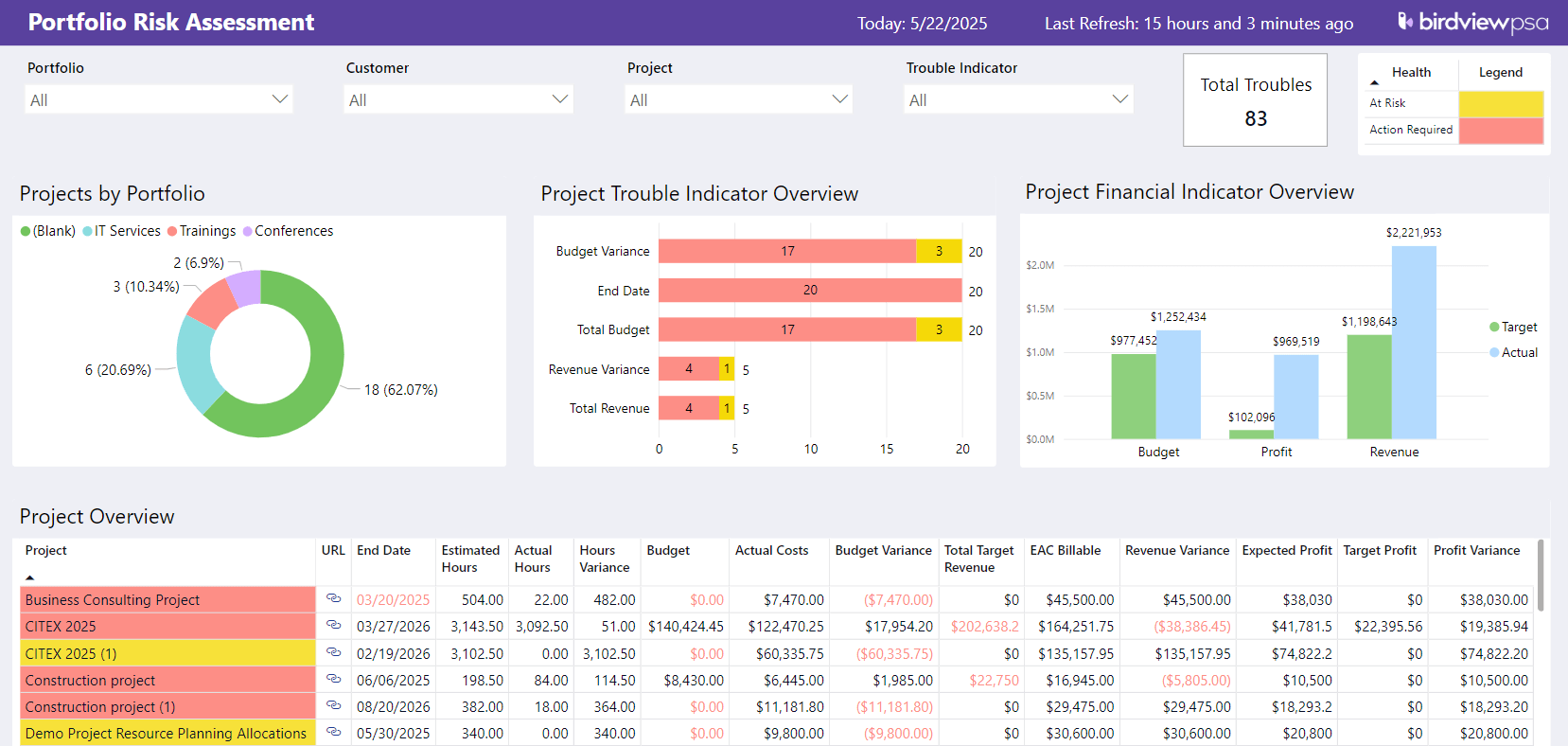Engineering projects are intricate undertakings. They involve complex designs, specialized resources, strict timelines, and budgets that demand rigorous control. You’re managing progress, coordinating teams, and mitigating risks, all while trying to answer the critical question: “Are we on track, and will we finish within budget?”
Relying solely on simple metrics like “percent complete” or comparing actual spend to the planned budget isn’t enough. These methods often tell you what happened in the past but fail to predict what will happen in the future or give you a clear picture of performance relative to the work actually accomplished. This lack of integrated insight makes it hard to catch problems early, make timely adjustments, and confidently predict project outcomes.
This is where Earned Value Analysis (EVA) becomes an indispensable tool for engineering firms. EVA is a powerful project management technique that integrates scope, schedule, and cost to provide a comprehensive, objective view of project performance. It helps you answer the tough questions, predict future performance, and regain control of your projects.
This article will explore the core concepts of Earned Value Analysis (EVA), explain why it’s particularly valuable for engineering firms, and show you how Birdview PSA simplifies EVA tracking, helping you manage your engineering projects with greater precision and predictability.
Why traditional tracking falls short for engineering projects
Engineering projects are too complex for simple tracking methods. Just knowing how much budget you’ve spent or what percentage of tasks are marked “complete” doesn’t tell the whole story:
- Simple Percent Complete: Knowing you’re 50% through the tasks doesn’t mean you’re 50% through the budget or schedule. Some tasks are more complex or resource-intensive than others.
- Tracking Actual Costs vs. Budget: Seeing you’ve spent 50% of your budget only tells you about spending, not about the value of the work accomplished with that spending. Are you overspending or underspending for the work done?
- Tracking Actual Time vs. Schedule: Knowing you’re halfway through the planned schedule doesn’t mean you’ve completed half the work. Delays early on can have a cascading effect that simple schedule tracking misses.
These traditional methods lack integration. They don’t connect what you’ve spent or how much time has passed with the actual value of the work completed. This makes it hard to spot the real problems early enough to do something about them.
What is Earned Value Analysis (EVA)? Connecting scope, schedule, and cost
Earned Value Analysis (EVA) is a project performance management technique that provides an objective way to measure project progress and performance. It achieves this by integrating three key dimensions:
- Planned Value (PV): The budgeted cost of the work scheduled to be completed by a specific point in time. This is your baseline plan’s value at a given point.
- Actual Cost (AC): The actual cost incurred for the work performed by that same point in time. This is how much you’ve actually spent.
- Earned Value (EV): The budgeted cost of the actual work completed by that same point in time. This is the value of the work you’ve accomplished, measured against the original budget for that work.
EVA compares these three values to assess if your project is on track in terms of both schedule and budget performance relative to the work actually done. It answers questions like:
- Are we getting the amount of work done that we planned to for the money we’ve spent? (Cost Performance)
- Are we getting the amount of work done that we planned to by this point in the schedule? (Schedule Performance)
Key metrics: CPI and SPI
1. Cost Performance Index (CPI): Measures how efficiently the project is utilizing the budget.
- Formula: CPI = EV / AC
- A CPI > 1 means the project is under budget.
- A CPI < 1 means the project is over budget.
F2. Schedule Performance Index (SPI): Measures whether the project is ahead or behind schedule.
- Formula: SPI = EV / PV
- An SPI > 1 means the project is ahead of schedule.
- An SPI < 1 means the project is behind schedule.
Where:
- EV (Earned Value): The value of work actually completed.
- AC (Actual Cost): The cost incurred so far.
- PV (Planned Value): The budgeted cost of work planned by this point.
Two ways to calculate EVA: based on hours and based on cost
Option 1: Earned Value Analysis based on hours
For teams primarily tracking hours, EVA can be applied by measuring the planned vs. actual hours spent.
- EV (Earned Value) = Total planned hours × % of work completed
- AC (Actual Cost) = Actual hours logged
- PV (Planned Value) = Planned hours up to the reporting period

- EV = 100 × 0.5 = 50 hours
- AC = 60 hours (actual time spent so far)
- PV = 70 hours (planned time by now)
CPI = 50 / 60 = 0.83 (over budget)
SPI = 50 / 70 = 0.71 (behind schedule)
Option 2: Earned Value Analysis based on cost
For teams that track financial performance, mostly in engineering, EVA can be applied by multiplying hours by an internal rate and adding expenses.
- EV = (Total planned hours × Internal rate × % of work completed) + (Total planned expenses x % of work completed)
- AC = (Actual hours × Internal rate) + Actual expenses
- PV = (Planned hours × Internal rate) + Planned expenses

- EV = (100 × $100 × 0.5) + (50,000 x 0.5) = $30,000
- AC = (60 × $100) + $45,000 = $51,000
- PV = (70 × $100) + $35,000 = $42,000
CPI = $30,000 / $51,000 = 0.59 (over budget)
SPI = $30,000 / $42,000 = 0.71 (behind schedule)
Why EVA is particularly valuable for engineering firms
Engineering projects have characteristics that make Earned Value Analysis (EVA) especially relevant and powerful:
- Predictability in Physical Deliverables: While designs can evolve, the completion of specific physical deliverables (foundation poured, structure framed, system installed) provides clear points for measuring “Earned Value” objectively.
- High Costs & Tight Budgets: Engineering projects often involve significant labor costs, material procurement, and equipment usage. EVA provides early warnings of budget overruns, allowing for corrective action before costs spiral out of control.
- Complex Dependencies & Long Timelines: Engineering projects have intricate task dependencies and can span months or years. EVA helps track progress relative to the schedule and identify if delays in one area are impacting the overall timeline.
- Resource-Intensive: Managing specialized engineering resources (engineers, technicians, specific equipment) is costly. EVA helps ensure that the spending on these resources is aligned with the value of the work they are producing.
- Objective Performance Measurement: EVA provides objective metrics (SPI and CPI) that can be used to assess project performance without relying solely on subjective opinions or simple percentage complete.
📚 You may also like:
The Expert’s Guide to Resource Planning
Engineering Resource Planning with Limited Resources
The challenge: manual EVA calculation is a headache
While the power of EVA is clear, manually calculating PV, EV, AC, SV, and CV for every task and project, especially as projects evolve and data changes, is incredibly time-consuming and prone to calculation errors. Keeping track of planned values, actual costs, and percentage complete for every work package across multiple projects in a spreadsheet is a significant administrative burden.
This is where PSA software with built-in Earned Value Analysis capabilities becomes essential.
📚 You may also like: Professional Services Automation Software: A Practical Guide
Birdview PSA: simplifying Earned Value Analysis for engineering firms
Birdview PSA integrates Earned Value Analysis (EVA) directly into its PSA software platform, automating the calculations and providing real-time visibility into your project’s performance. It transforms EVA from a complex manual process into an actionable tool for managing your engineering projects.
Here’s how Birdview PSA simplifies EVA tracking:
- Real-Time EVA Metrics (SPI, CPI): Based on the calculated PV, EV, and AC, Birdview PSA instantly computes your Schedule Performance Index (SPI), and Cost Performance Index (CPI). These metrics are updated in real-time as your team logs time and updates task progress.
- Visual Performance Indicators: Birdview PSA uses visual indicators (like color-coded dashboards or icons) to quickly show you the status of your projects based on EVA metrics. You can see at a glance if a project is ahead of schedule (SPI > 1) or over budget (CPI < 1).
- EVA at Different Levels: Birdview PSA can calculate EVA not just for the overall project, but also for individual phases, tasks, or even WBS elements. This allows you to pinpoint exactly where performance issues are occurring.
- Reporting and Dashboards: Access customizable Business Intelligence reports and dashboards in Birdview PSA that clearly display your EVA metrics. Share these reports with stakeholders to provide objective updates on project performance. Birdview PSA’s Business Intelligence reporting makes EVA data accessible.

Using EVA insights to drive engineering project success
Earned Value Analysis (EVA) in Birdview PSA provides powerful insights that enable you to take proactive action and keep your engineering projects on track:
- Early Problem Detection: EVA alerts you to performance issues (schedule or cost) early in the project lifecycle, when it’s easier and less costly to make adjustments.
- Informed Decision-Making: Use EVA metrics to make data-driven decisions about resource allocation, scope changes, or necessary interventions. For example, if CPI is low, you might need to investigate cost drivers or improve productivity.
- Accurate Forecasting: EVA helps you predict the final project cost and completion date with greater confidence, allowing you to manage stakeholder expectations effectively.

- Performance Improvement: Analyze EVA data from completed projects to identify areas for improvement in your estimating, planning, and execution processes for future engineering projects.
- Objective Communication: Share EVA reports with clients and stakeholders to provide objective and transparent updates on project performance.
📚 You may also like:
Project cost estimation guide
Project cost control
Implementing EVA in your engineering workflow with Birdview PSA
Ready to move beyond gut feel and start using Earned Value Analysis to manage your engineering projects? Here are the basic steps for implementing EVA in Birdview PSA:
- Define a Baseline: Set up your initial project plan in Birdview PSA with a detailed scope, schedule, and budget. This establishes your Planned Value (PV) over time.
- Track Actual Costs and Expenses: Ensure your team is diligently logging their time against tasks (labor costs) and recording project expenses in Birdview PSA. This provides your Actual Cost (AC).
- Update Task Progress: Regularly update the percentage complete for tasks within Birdview PSA. This is crucial for calculating the Earned Value (EV).
- Monitor EVA Metrics: Use Birdview PSA’s dashboards and reports to monitor your Schedule Variance (SV), Cost Variance (CV), Schedule Performance Index (SPI), and Cost Performance Index (CPI) regularly.
- Take Action Based on Insights: When KPIs indicate performance issues (e.g., SPI or CPI less than 1), investigate the root cause using the detailed EVA data in Birdview PSA and take corrective action.
- Refine Future Planning: Use the EVA data from completed projects to improve the accuracy of your estimating and planning for future engineering projects.
By consistently following these steps, you can leverage Earned Value Analysis in Birdview PSA to gain greater control and predictability over your engineering projects.
For engineering firms, mastering Earned Value Analysis (EVA) is crucial for moving beyond traditional tracking methods and gaining true insight into project performance. EVA connects scope, schedule, and cost, providing objective metrics that help you identify issues early, predict outcomes, and make informed decisions.
While manual EVA calculations can be cumbersome, Birdview PSA simplifies the process by integrating Earned Value Analysis directly into its PSA software platform. It automates the calculations, provides real-time visual indicators, and delivers the reports you need to manage your engineering projects with greater precision and predictability.
Stop managing your engineering projects in the dark. Empower your team and your business with the clarity and control of Earned Value Analysis in Birdview PSA.
Ready to gain objective insight into your engineering project performance?
Discover how Birdview PSA’s built-in Earned Value Analysis can help you track, predict, and control your projects.
or



